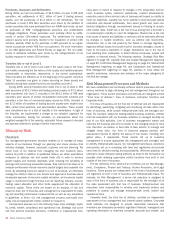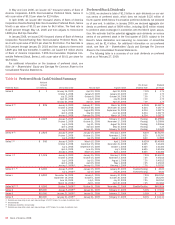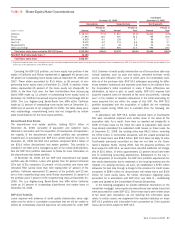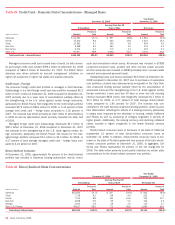Bank of America 2008 Annual Report Download - page 63
Download and view the complete annual report
Please find page 63 of the 2008 Bank of America annual report below. You can navigate through the pages in the report by either clicking on the pages listed below, or by using the keyword search tool below to find specific information within the annual report.Credit Risk Management
The housing downturn and the financial market disruptions that began in
the second half of 2007 have continued to affect the economy and the
financial services sector in 2008. The housing downturn and the broader
economic slowdown accelerated during the second half of 2008 and
negatively impacted the credit quality of both our consumer and commer-
cial portfolios. The depth and breadth of the downturn as well as the
resulting impacts on the credit quality of our portfolios remain unclear.
However, we expect continued market turbulence and economic
uncertainty to continue well into 2009. This will result in higher credit
losses and provision for credit losses in future periods.
Credit risk is the risk of loss arising from the inability of a borrower or
counterparty to meet its obligations. Credit risk can also arise from opera-
tional failures that result in an erroneous advance, commitment or
investment of funds. We define the credit exposure to a borrower or coun-
terparty as the loss potential arising from all product classifications
including loans and leases, deposit overdrafts, derivatives, assets
held-for-sale and unfunded lending commitments that include loan com-
mitments, letters of credit and financial guarantees. Derivative positions
are recorded at fair value and assets held-for-sale are recorded at fair
value or the lower of cost or fair value. Certain loans and unfunded com-
mitments are accounted for at fair value in accordance with SFAS 159.
Credit risk for these categories of assets is not accounted for as part of
the allowance for credit losses but as part of the fair value adjustment
recorded in earnings in the period incurred. For derivative positions, our
credit risk is measured as the net replacement cost in the event the
counterparties with contracts in a gain position to us fail to perform under
the terms of those contracts. We use the current mark-to-market value to
represent credit exposure without giving consideration to future
mark-to-market changes. The credit risk amounts take into consideration
the effects of legally enforceable master netting agreements and cash
collateral. Our consumer and commercial credit extension and review
procedures take into account funded and unfunded credit exposures. For
additional information on derivatives and credit extension commitments,
see Note 4 – Derivatives and Note 13 – Commitments and Contingencies
to the Consolidated Financial Statements.
For credit risk purposes, we evaluate our consumer businesses on
both a held and managed basis. Managed basis assumes that credit card
loans that have been securitized were not sold and presents earnings on
these loans in a manner similar to the way loans that have not been sold
(i.e., held loans) are presented. We evaluate credit performance on a
managed basis as the credit card receivables that have been securitized
are subject to the same underwriting, servicing, ongoing monitoring and
collection standards as held loans. In addition to the discussion of credit
quality statistics of both held and managed credit card loans included in
this section, refer to the Card Services discussion on page 35. For addi-
tional information on our managed portfolio and securitizations, see Note
8 – Securitizations to the Consolidated Financial Statements.
We manage credit risk based on the risk profile of the borrower or
counterparty, repayment sources, the nature of underlying collateral, and
other support given current events, conditions and expectations. We
classify our portfolios as either consumer or commercial and monitor
credit risk in each as discussed below.
We continue to refine our credit standards to meet the changing
economic environment. We have adjusted our underwriting criteria, as
well as enhanced our line management and collection strategies across
the consumer businesses in an attempt to mitigate losses. We have
increased our collections and customer assistance infrastructure in order
to enhance customer support.
In our domestic consumer credit card business, we have implemented
a number of initiatives to mitigate losses including increased use of
judgmental lending, adjusted underwriting, account and line management
standards, particularly in higher-risk geographies, and increased collec-
tions staffing levels. In response to the significant deterioration in our
consumer real estate portfolio we have implemented initiatives including
underwriting changes on newly originated consumer real estate loans
which increased the minimum FICO score and reduced the maximum
loan-to-value (LTVs) and combined loan-to-values (CLTVs). Additional LTV
and CLTV reductions were implemented for higher risk geographies. In our
home equity portfolio, we have also reduced unfunded lines on deteriorat-
ing accounts with declining equity positions.
In response to weakness in our direct/indirect portfolio, we have
implemented several initiatives to mitigate losses. In our unsecured lend-
ing business we have increased the use of judgmental lending and tighter
underwriting and account management standards for higher risk custom-
ers and higher-risk geographies. In our automotive and dealer-related
portfolios, we have tightened underwriting criteria and improved the risk-
based pricing for purchased loans.
To mitigate losses in the commercial businesses, we have increased
the frequency and intensity of portfolio monitoring, hedging activity and
our efforts in managing the exposure when we begin to see signs of dete-
rioration. As part of our underwriting process we have increased scrutiny
around stress analysis and required pricing and structure to reflect cur-
rent market dynamics. Given the volatility of the financial markets, we
increased the frequency of various tests designed to understand what the
volatility could mean to our underlying credit risk. Given the single name
risk associated with the problems in the financial markets, we used a
real-time counterparty event management process to monitor key
counterparties. A number of initiatives have also been implemented in our
small business commercial – domestic portfolio including changes to
underwriting thresholds, augmented by a granular decision making proc-
ess by experienced underwriters including increasing minimum FICO
scores and lowering initial line assignments. We have also decreased
credit lines on higher risk customers in higher risk states and industries.
Further, we are increasing our customer assistance and collections
infrastructure and have instituted a number of other initiatives related to
our credit portfolios in an attempt to mitigate losses and enhance our
support for our customers. To help homeowners avoid foreclosure, Bank
of America and Countrywide modified approximately 230,000 home loans
during 2008. The majority of these home retention solutions were
extended as part of a broader initiative to offer modifications for approx-
imately $100 billion in mortgage financing for up to 630,000 borrowers
over the next several years. In addition to being committed to the loan
modification programs the Corporation continued to focus on lending by
extending more than $115 billion of new credit during the fourth quarter.
For more information, see Recent Events on page 22.
On July 1, 2008, the Corporation acquired Countrywide creating one of
the largest mortgage originators and servicers. We will continue our prac-
tice of not originating subprime mortgages and certain nontraditional
mortgages, and as such will not offer products such as Countrywide’s
pay-option and payment advantage ARMs (pay option loans), which we
classify as discontinued real estate in the Consumer Portfolio Credit Risk
Management discussion. We have significantly curtailed the production of
other nontraditional mortgages, such as certain low-documentation loans.
In addition, we will continue to offer first-lien mortgages conforming to
the underwriting standards of GSEs and the government, including loans
supported by the FHA and the Department of Veterans Affairs and other
loans designed for low and moderate income borrowers (e.g., Community
Reinvestment Act loans). We will also continue to offer first-lien
non-conforming loans, interest-only fixed-rate and ARMs that are subject
to a 10-year minimum interest-only period, and fixed-period ARMs.
Bank of America 2008
61
























